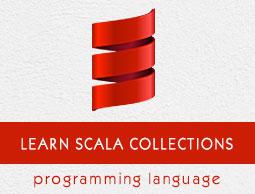Scala Collections - Set
Scala Set is a collection of pairwise different elements of the same type. In other words, a Set is a collection that contains no duplicate elements. There are two kinds of Sets, the immutable and the mutable. The difference between mutable and immutable objects is that when an object is immutable, the object itself can't be changed.
By default, Scala uses the immutable Set. If you want to use the mutable Set, you'll have to import scala.collection.mutable.Set class explicitly. If you want to use both mutable and immutable sets in the same collection, then you can continue to refer to the immutable Set as Set but you can refer to the mutable Set as mutable.Set.
Here is how you can declare immutable Sets −
Syntax
// Empty set of integer type
var s : Set[Int] = Set()
// Set of integer type
var s : Set[Int] = Set(1,3,5,7)
or
var s = Set(1,3,5,7)
While defining an empty set, the type annotation is necessary as the system needs to assign a concrete type to variable.
Basic Operations on set
All operations on sets can be expressed in terms of the following three methods −
| Sr.No |
Methods & Description |
| 1 |
head
This method returns the first element of a set.
|
| 2 |
tail
This method returns a set consisting of all elements except the first.
|
| 3 |
isEmpty
This method returns true if the set is empty otherwise false.
|
Try the following example showing usage of the basic operational methods −
Example
object Demo {
def main(args: Array[String]) {
val fruit = Set("apples", "oranges", "pears")
val nums: Set[Int] = Set()
println( "Head of fruit : " + fruit.head )
println( "Tail of fruit : " + fruit.tail )
println( "Check if fruit is empty : " + fruit.isEmpty )
println( "Check if nums is empty : " + nums.isEmpty )
}
}
Save the above program in Demo.scala. The following commands are used to compile and execute this program.
Command
\>scalac Demo.scala
\>scala Demo
Output
Head of fruit : apples
Tail of fruit : Set(oranges, pears)
Check if fruit is empty : false
Check if nums is empty : true
Concatenating Sets
You can use either ++ operator or Set.++() method to concatenate two or more sets, but while adding sets it will remove duplicate elements.
The Following is the example to concatenate two sets.
Example
object Demo {
def main(args: Array[String]) {
val fruit1 = Set("apples", "oranges", "pears")
val fruit2 = Set("mangoes", "banana")
// use two or more sets with ++ as operator
var fruit = fruit1 ++ fruit2
println( "fruit1 ++ fruit2 : " + fruit )
// use two sets with ++ as method
fruit = fruit1.++(fruit2)
println( "fruit1.++(fruit2) : " + fruit )
}
}
Save the above program in Demo.scala. The following commands are used to compile and execute this program.
Command
\>scalac Demo.scala
\>scala Demo
Output
fruit1 ++ fruit2 : Set(banana, apples, mangoes, pears, oranges)
fruit1.++(fruit2) : Set(banana, apples, mangoes, pears, oranges)
Find Max, Min Elements in a Set
You can use Set.min method to find out the minimum and Set.max method to find out the maximum of the elements available in a set. Following is the example to show the program.
Example
object Demo {
def main(args: Array[String]) {
val num = Set(5,6,9,20,30,45)
// find min and max of the elements
println( "Min element in Set(5,6,9,20,30,45) : " + num.min )
println( "Max element in Set(5,6,9,20,30,45) : " + num.max )
}
}
Save the above program in Demo.scala. The following commands are used to compile and execute this program.
Command
\>scalac Demo.scala
\>scala Demo
Output
Min element in Set(5,6,9,20,30,45) : 5
Max element in Set(5,6,9,20,30,45) : 45
Find Common Values Insets
You can use either Set.& method or Set.intersect method to find out the common values between two sets. Try the following example to show the usage.
Example
object Demo {
def main(args: Array[String]) {
val num1 = Set(5,6,9,20,30,45)
val num2 = Set(50,60,9,20,35,55)
// find common elements between two sets
println( "num1.&(num2) : " + num1.&(num2) )
println( "num1.intersect(num2) : " + num1.intersect(num2) )
}
}
Save the above program in Demo.scala. The following commands are used to compile and execute this program.
Command
\>scalac Demo.scala
\>scala Demo
Output
num1.&(num2) : Set(20, 9)
num1.intersect(num2) : Set(20, 9)


